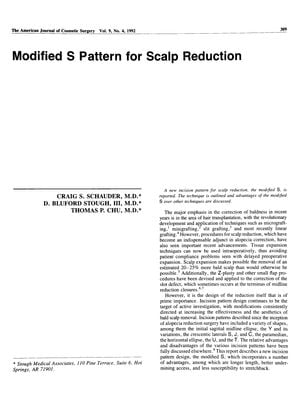TLDR The modified S pattern for scalp reduction is effective for removing more bald scalp and hiding scars in hair restoration.
The document reports on a new incision pattern for scalp reduction, the modified S, which has been used in over 30 cases over the course of approximately one year. This pattern is designed to improve the effectiveness and aesthetics of bald scalp removal. The modified S pattern is characterized by a small tight curve anteriorly and a looser, more sweeping curve posteriorly, which allows for the removal of more bald scalp per procedure, easier undermining, and better scar concealment. The pattern also distributes tension more widely, potentially reducing the tendency toward stretchback. The authors argue that scalp reduction, particularly with this new pattern, should be the procedure of choice for patients with vertex alopecia and, when combined with hair transplantation, offers excellent hair restoration. Results from the cases show marked improvements in patients with extensive alopecia, with the pattern allowing for a greater amount of bald scalp to be removed and the scar to be camouflaged effectively.
 21 citations
,
August 1991 in “The Journal of Dermatologic Surgery and Oncology”
21 citations
,
August 1991 in “The Journal of Dermatologic Surgery and Oncology” Using tissue expanders and hyaluronidase in scalp reduction surgery allows for more scalp removal and easier surgery.
 33 citations
,
January 1991 in “The Journal of Dermatologic Surgery and Oncology”
33 citations
,
January 1991 in “The Journal of Dermatologic Surgery and Oncology” Incisional slit grafting for hair transplantation gives natural-looking results and has a high success rate.
 3 citations
,
July 1997 in “Current problems in dermatology”
3 citations
,
July 1997 in “Current problems in dermatology” Hair restoration surgery has evolved over time, with a focus on natural-looking results and managing patient expectations, while also considering potential complications and the lifelong progression of male pattern baldness.
 6 citations
,
September 1997 in “Dermatologic Surgery”
6 citations
,
September 1997 in “Dermatologic Surgery” Chest hair can be used for scalp hair transplants when there's not enough scalp hair.
 10 citations
,
December 1997 in “Plastic and Reconstructive Surgery”
10 citations
,
December 1997 in “Plastic and Reconstructive Surgery” Hair restoration surgery has improved with better techniques for natural looks and managing patient expectations, but it remains labor-intensive and requires careful consideration of potential complications.
 5 citations
,
March 1985 in “Head & Neck Surgery”
5 citations
,
March 1985 in “Head & Neck Surgery” Combining scalp reduction and hair transplants improves coverage and appearance for male baldness.
 3 citations
,
February 1996 in “Dermatologic Surgery”
3 citations
,
February 1996 in “Dermatologic Surgery” Walter P. Unger suggests using advanced hair transplant techniques for broader coverage, as they provide natural results and use donor tissue efficiently, while also recommending personalized planning due to the unpredictable progression of baldness.








